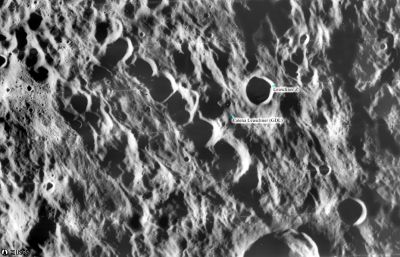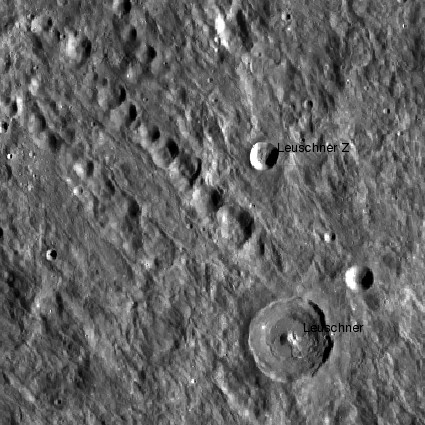Catena Leuschner (GDL)
Contents
Catena Leuschner (GDL)
| Lat: 5.07°N, Long: 111.3°W, Length: 200.06 km, Depth: km, Rükl: (farside) | |
right: LROC
Images
LPOD Photo Gallery Lunar Orbiter Images Apollo Images
Maps
(LAC zone 71C2) USGS Digital Atlas PDF
Description
Catena Leuschner lies some 350 kilometres away east of the Hertsprung Basin and, roughly, the same distance away from the Orientale Basin to its south-east. Creation of the catena is believed to be the result of chunks or blocks of material ejected from this latter basin, as the chain of craters lie radially to it. Several other catenae in the region, for example, Catena Michelson and Catena Lucretius which lie southwards of Catena Leuschner also radial to Orientale, so its influence has changed the surrounding landscape dramatically. The catena itself is made up of of eight well-defined, equally-sized craters that range from about 20 kilometres in diameter at its south-eastern end to 15 kilometres at its north-western end. On closer examination, the catena show overlapping signatures with other chains of craters nearby; along with craterlets, late ejecta deposits, and a non-linear direction from is source. Its
formation was therefore of a complex nature. The relatively small Leuschner crater (~ 49 Diam., and of Erastothenian in age) lying at the south-eastern end just about touches the catena, however, it is totally unrelated to its formation and only gives its name to it.- JohnMoore2
Wikipedia
Additional Information
- IAU page: Catena Leuschner (GDL)
- List of Lunar Catenae.
Nomenclature
- This feature is named from nearby crater, Leuschner. The parenthetical abbreviation (GDL) stands for the Gas Dynamics Laboratory, a Russian scientific institute.
- The name GDL was proposed for this feature on the Complete Map of the Moon (1967/1969) made under the direction of the Sternberg Institute, and presented to the IAU in 1967.
- The idea of naming catenae after institutes was considered by the IAU starting in 1970.
- The idea of naming catenae after institutes was not accepted, and in 1976 this feature was officially named Catena Leuschner (without the parenthesis). However, in 1979, the IAU began recommending that the name of this, and two other catenae, be printed on maps followed by the initials in parenthesis to "provide a cross-reference to the earlier Soviet lunar maps."
LPOD Articles
Bibliography
Named Features -- Prev: Leucippus -- Next: Leuschner

